Are you a writer? Do you like learning about the creative process, either for your own projects, or just cause you think it’s interesting? This post is about to make your day. As I’m sure you know, there is a booming industry of books on the art and craft of writing, from all sort of different authors, who cover all sorts of different angles. I’ve rounded up 18 of my favorites.
Let me start with one piece of my own advice: all of the books on this list are very good, and helpful, and if you’re a writer I think you should read them! BUT: What makes a writer is creating a space, as often as possible, to think and write. And that can mean many things! It can be typing into a notes app during your baby’s nap, it can mean an hour before work each day, it can mean sitting under a tree with a Moleskine and a fancy pen, it can mean one long writing session a week, or dictating during your commute, or staying up until 4AM writing fic.
Also read as much as possible, in as many genres as possible—and to that end, here’s a book list!
Never Say You Can’t Survive by Charlie Jane Anders
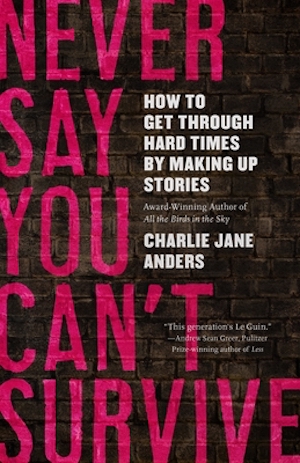
Charlie Jane Anders has been gifting us all with incredible writing advice for years. (I wrote a post about it way back in 2014!) In the wake of the 2016 election, she found herself thinking even more than usual about the ways stories can help us cope with pain, and how the act of writing itself can become a structure for a person who feels like their life, or country, is in danger of collapse. Her thoughts resulted in a fantastic series of essays, which gradually became a book of writing craft, advice, and a bit of memoir. Some of those essays have been published here on TorDot (in a series also titled “Never Say You Can’t Survive”) and now the entire book will be available in August!
A throughline of the book is the idea that by building worlds of your own, it can better help you cope with problems in this world we all share. Anders is especially dedicated to the importance of escapism:
And escapism is resistance. People sometimes talk about escapist storytelling as a kind of dereliction of duty, as if we’re just running away from the fight. That’s some bullshit right there. In her 1979 essay collection The Language of the Night, Ursula K. Le Guin paraphrases Tolkien thusly: “If a soldier is captured by the enemy, don’t we consider it his duty to escape? …. If we value the freedom of the mind and soul, if we’re partisans of liberty, then it’s our plain duty to escape and to take as many people with us as we can.”
She talks about practical stuff, like worldbuilding and plotting, but she also digs into the emotional side of writing, discussing imposter syndrome, how to use anger, how to protect your own personal weirdness, and how to channel your political beliefs into your work without getting too pedantic. This is a great book for anyone working on their writing, but it’s a particular goldmine for those of use working in science fiction, fantasy, and horror.
Wonderbook by Jeff VanderMeer
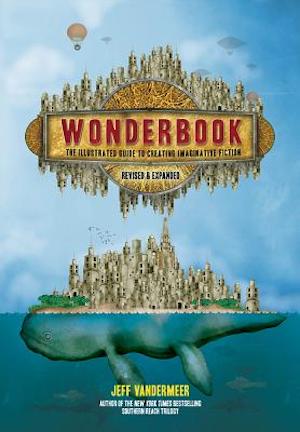
Of all the books on this list, Jeff VanderMeer’s Wonderbook is the most expansive. The exercises in the book are all about short circuiting your usual patterns of thought, and opening you up to the idea that, really, a story can be anything, and it can go anywhere. Rather than simply relying on chunks of text and straight-ahead writing advice, VanderMeer uses illustrations, asides, sidebars, and a whole interactive site to create a conversation with his reader. He also includes a number of essays from other writers—often writers who directly disagree with advice he’s just given—to create a polyphonous craft book. This serves a purpose that I think is rare in even the most well-meaning piece of writing advice: it reminds you that writing, and all art, (and, hell, life) is FLUX. There are no set answers. Your book (or painting, or symphony) is your art. It can be whatever you want. And the craft discussion around that isn’t a top-down lecture, it’s a conversation, an argument, and occasionally a fantastical fishbeast with a city on its back.
On Writing: A Memoir of the Craft by Stephen King
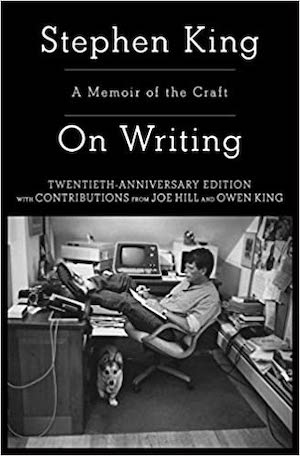
This one is a classic for a reason! Stephen King started writing On Writing in 1997, but put it aside for a while and debated finishing it. He came back to the project and finished a draft in early 1999. Then, in June 1999, he was struck by a van and nearly killed during a walk. After months of surgeries and physical therapy, he wasn’t sure whether he’d ever write again, and found it nearly impossible to start new projects. On Writing was the one work he was able to return to—adding a new section about the accident, and turning the book into more of a memoir than a craft book. As he wrote, he found that a new topic awaited him: what he really cared about now was talking about why he wrote. And why he thinks other people should write. This book has great practical advice, and some stern “keep your ass in the chair” energy that you want in a writing book, but moreso it’s a powerful reminder of why storytelling is vital to human life.
On Writing is arranged into “C.V.”, “What Writing Is”, “Toolbox”, “On Writing”, and “On Living: A Postscript”—“C.V.” is a mini-memoir with a focus on how his writing and life intertwine, the middle sections are the how-to sections (which draw examples from everyone from Truman Capote to Johns Steinbeck and Grisham to Mary Karr to H.P. Lovecraft to Charles Dickens), and the last is his recounting of the van accident that nearly killed him.
We’re in King Country here, so he opens with three forwards, including one where he tells you how he came to be in an all-author band called The Rock Bottom Remainders, which in turn led to the conversation with Amy Tan that inspired On Writing. They were talking about how people at author Q&As always ask the DeLillos, Updikes, and Styrons about their craft, but those kinds of questions never come up with popular novelists. This is an important note: King wrote this book explicitly to be for people who want to write strong, popular work. Horror, sci-fi, romance—I think now most people understand that those are all valid genres, but when King was writing this book in the late ‘90s the literary world was very much a snobs-vs-slobs scenario. (Which I think makes Michael Chabon…Bill Murray?) But the heart of the book can be summed up with the reminder King gives you at the ending of the “C.V.” section: “…put your desk in the corner, and every time you sit down there to write, remind yourself why it isn’t in the middle of the room. Life isn’t a support-system for art. It’s the other way around.”
About Writing by Samuel R. Delany
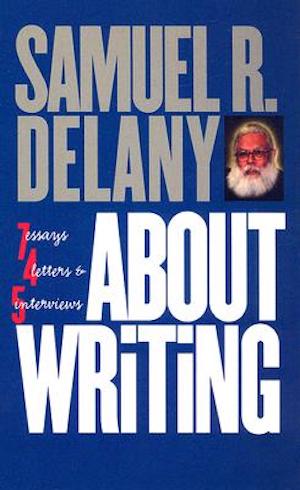
Of all the writers on this list, Delany probably has the greatest breadth. He’s written space opera, high fantasy, poetry, short stories, fable, an epoch-defining work of counterculture, memoir, porn, critical essays, comics—you name it, he has it in a book, or in a drawer somewhere. About Writing is a pretty high level craft book. While he gives advice, especially in an appendix subtitled “Nits, Nips, Tucks, and Tips”, he’s more interested into digging into story structure, talking about shaping paragraphs, and wrestling with the work of other writers. He’s also very clear on one daunting concept, and that daunting concept is IN GERMAN, so you know he’s serious. If you think you want to write, you better make sure you have Begeisterung, the spirit of inspiration and determination that drives a person to create in the face of a vast and unknowable universe.
So check and make sure you’ve got some of that, and then break out your pen.
Meander Spiral Explode by Jane Alison
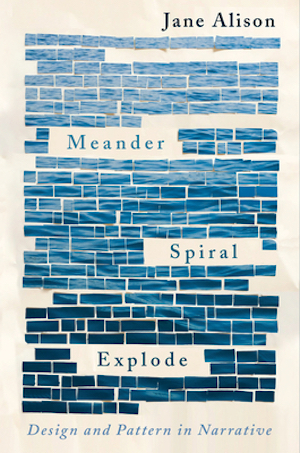
Meander Spiral Explode might be the most purely helpful craft book I’ve ever read. Its author, Jane Alison, has worked as a copywriter, written five novels, a memoir, and a book about Ovid’s poetry (one of her novels, The Love-Artist, is also about Ovid and a possibly magical woman he encounters) and has taught in various capacities for decades—an excellent writer’s C.V.—but what makes MSE so good is that she rejects a lot of the standard work of a craft book. There are no admonitions about writing every day, or staying in the chair a certain amount of time, or arguments about whether MFAs are useful or not. Instead, Alison talks about shape. Most of us were probably taught things about rising action and conflict and denouement (a word I still to this day pronounce “duh-noo-mint”), but Alison points out that there is no law that says a story has to be shaped into a triangle:
The arc is an elegant shape, especially when translated to its natural form, a wave. Its rise and fall traces a motion we sense in heartbeats, breaking surf, the sun, and there’s real power in a wave’s movement from beginning to midpoint to end. But something that swells and tautens until climax, then collapses: a little masculo-sexual, no? Why is this the form we should expect our stories to take?
You can read some of her thoughts in this Paris Review essay, but the book goes much further in imagining different shapes and patterns a story can take, often drawing from nature. Spirals, capillaries, nautilus shells, spiky cacti, ocean waves—it’s a great reminder that a story can be anything, something I think is especially useful for those of us writing SFFH.
Creating Short Fiction by Damon Knight
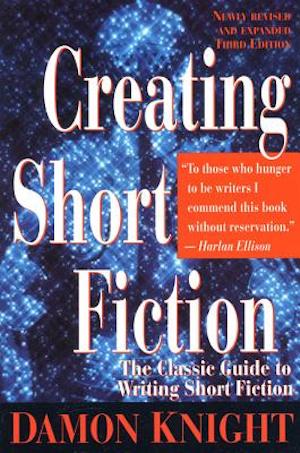
Damon Knight is a giant of SFF. He wrote “To Serve Man”, was a member of The Futurians, founded the Science Fiction and Fantasy Writers of America and co-found the Clarion Writers Workshop, popularized the term “idiot plot”, became a Grand Master in 1994 and won a Hugo for his reviewing back when they used to give out awards for criticism. (AHEM.)
In the early 80s, he wrote one of the all-time classic books of writing advice: Creating Short Fiction, which was updated and expanded several times. Why is it an all-time classic? He breaks the daunting task of writing a story into small, achievable goals with exercises on learning to see, learning to remember, building conflict, asking your characters questions, and choosing which point of view will work best for you. And in addition to those very practical steps, he also talks about more nebulous problems, as in a chapter titled “What to Do When You’re Stuck”. Plus, he dedicates an entire section to life as a working writer, with advice on how to develop solid work habits, how to cope with despair and rejection, how to network, and how to decide whether drugs might help.
Zen in the Art of Writing by Ray Bradbury
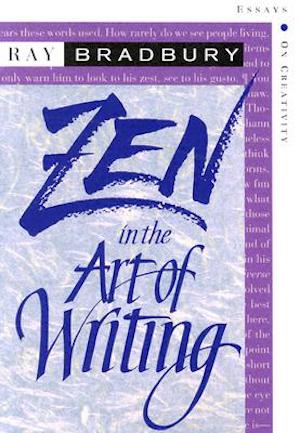
If you want a sense of the flavor of Bradbury’s book of craft essays, in the preface he asks, “What does writing teach us?”
First and foremost, it reminds us that we are alive and that it is a gift and a privilege, not a right. We must earn life once it has been awarded us. Life asks for rewards back because it has favored us with animation.
So while our art cannot, as we wish it could, save us from wars, privation, envy, greed, old age, or death, it can revitalize us amidst it all.
Secondly, writing is survival. Any art, any good work, of course, is that.
A few paragraphs later, he advises: “You must stay drunk on writing so reality cannot destroy you.” This is all by way of warning you what you’re in for with this book. This is my personal favorite type of craft book, where the author grabs you by a pair of imaginary lapels and lifts you off the floor and reminds you that writing is joyful and exuberant—even if it doesn’t always feel like it. You are creating something where there was nothing, and that is not a thing to be taken lightly. And sure, Bradbury walks you through his early days of keeping lists that later became classic stories, gives brief retellings of writing classics like Dandelion Wine and The Martian Chronicles, and dispenses excellent practical advice. But he also gives essays titles like “How to Keep and Feed a Muse”, and reminds you that writers are fucking magicians.
And we are.
Playing in the Dark: Whiteness and the Literary Imagination by Toni Morrison
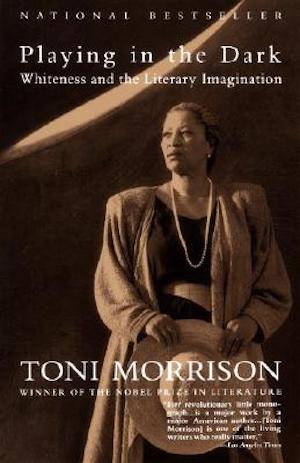
Playing in the Dark grew out of a series of lectures Toni Morrison (the author of The Great American Horror Novel That Might Also Just Be The Great American Novel) gave at Harvard, and it does what it says on the tin: Morrison guides you through the work of Mark Twain, Ernest Hemingway, Willa Cather, and especially Edgar Allan Poe (“No early American writer is more important to the concept of African Americanism than Poe.”) to look at the way white writers use “Blackness” as a concept, and Black bodies as objects, to define whiteness in their storytelling.
This isn’t a craft book, but anyone who wants to write seriously should read it.
A Swim in a Pond in the Rain by George Saunders
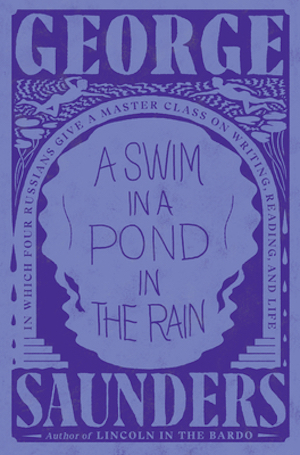
George Saunders is one of our best short story authors, full stop, but he’s particularly beloved for his ability to jump between hard-edged realism and genre-defying stories of zombies, ghosts, and failing near-future theme parks. He’s also a renowned writing teacher, who’s been teaching in Syracuse University’s MFA program since 1997. In his first craft book, he has taken lessons and anecdotes from his popular Syracuse course on the Russian short story and spread them out over nine chapters that cover seven classic stories. The book reprints the stories in full, and each chapter takes you through them in different ways. For Anton Chekhov’s “In the Cart”, you read one page at a time, with Saunders’ commentary breaking the story up to discuss structure and tension as you go. With Ivan Turgenev’s “The Singers”, you read the entire piece, and then get an essay on Turgenev’s life, and historical context, and how that shaped his writing. The book is great, and you can listen to an interview with Saunders about his hopes for the book here. And heck, have his recent interview with Seth Meyers, where he talks about story as memory:
https://www.youtube.com/watch?v=kuek8HRt37g
Craft in the Real World: Rethinking Fiction Writing and Workshopping by Matthew Salesses
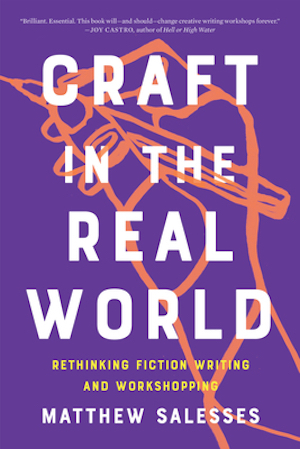
You know how it’s become popular to talk about decolonizing your bookshelf? That’s a great thing for readers to think about, but Salesses’ book is all about how to decolonize at the source: first, in your own writing, and then in workshops you attend and/or lead. Salesses is the author of The Hundred-Year Flood and Disappear Doppelgänger Disappear and teaches at Coe College. With his first book of craft essays he gives pointed advice on how to combat racism in workshop, and also how to write from your culture without centering white readers, male readers, straight readers, etc. He works through excerpts from classics like A Wizard of Earthsea and One Thousand and One Nights, and includes sections on how teachers can rethink their syllabi and grading systems to be more inclusive, and how writer, especially those starting out, can make sure that they’re telling the stories they want to tell, not the ones they feel they’re supposed to tell. He also points out many MFA programs, having been founded and run by white, middle-class writers, center a particular type of linear, U.S.-ian storytelling. To illustrate this he spends a chapter walking readers through the differences between Chinese and Western storytelling, which you can read here!
Storyteller by Kate Wilhelm
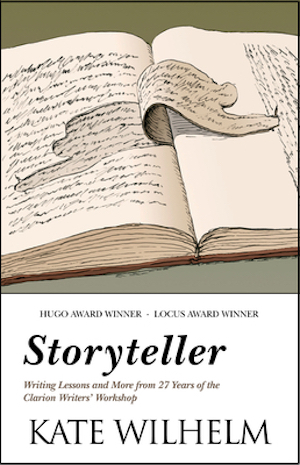
A very different beast than Damon Knight’s practical how-to, Storyteller is more of the memoir/craft hybrid that I especially love. In this case, the memoir portion tells the story of the founding and growth of the Clarion Writers’ Workshop, and tells about thirty years’ worth of tales of the SFF community. That alone would be a great read, but Wilhelm intersperses the memories and anecdotes with her thoughts on the art of writing. Of course, there’s a reason Clarion is a legendary workshop, and that reason comes through: for all the guidance a newer writer receives, the instructors are also willing to critique, and expect their students to put in the work to become truly professional writers, and this book also outlines the necessity of leaving any preciousness at the door when it’s time to workshop a story or listen to an editor.
How to Write an Autobiographical Novel by Alexander Chee
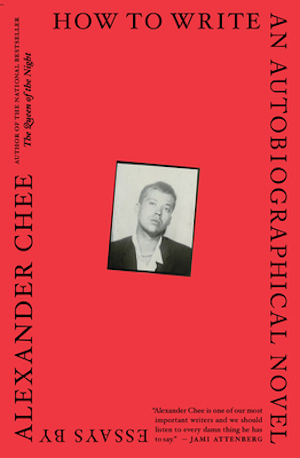
This is NOT a how-to book! But I’m including it on this list because it has some excellent practical advice along with personal essays. Like On Writing, this collection of linked essays is as much memoir as book about writing, but that’s kind of the point: in nearly every essay Chee talks about how his “life” and “life as a writer” are inextricable. He also shows just how much breadth a writing life can have: from X-Men fanfic to historical novels to “shitty autobiographical first novels” (spoiler alert: his first novel is absurdly, ridiculously good) to short stories to gardening journals, all of the writing expresses different parts of his personality. And, again like King, Chee is only too willing to talk about money. He tracks a lot of the jobs he needed to take to get by, the horrible intersection of grief and freedom he felt in the wake of an inheritance, his constant negotiations of class and race as he dealt with the world of New York publishing.
On a more personal note, I’ve been lucky enough to take a couple of classes with Chee, and they’ve been ridiculously helpful to my own process. Given that, I’m sharing this lecture/reading he gave at Brown that’s full of excellent advice:
This Year You Write Your Novel by Walter Mosley
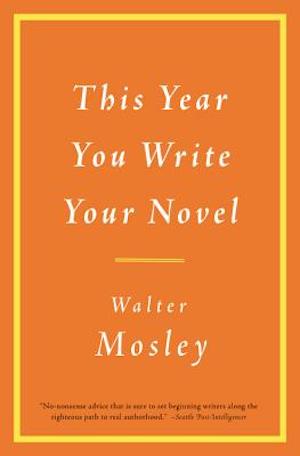
Now for another angle on the he Bradbury approach—while Mosley also stresses the importance of letting your subconscious loose in your writing, he’s a lot more focused on the practical aspect of the job. He’ll guide you through exactly what the title promises, giving you advice and exercises to write a novel-length project in a year. He crunches the numbers for you, and reminds you that if you can get 600-1,200 words down every day, you’ll have 60,000 words in three months—i.e. a short novel. But he also stresses that the most important part of writing is rewriting, which is why he didn’t title the book This Summer You Totally Complete And Publish Your Short Novel. He recommends an at least 90 minutes a day, and a lot of editing and rewriting to polish that initial chonk of 60,000 words into a book you might be able to publish. And even there, Mosley is willing to tell his own stories of rejection—even after dozens of books! And the creation of an all-time classic gumshoe! And a movie adaptation with Denzel Washington!—to remind you that the work’s never really over.
Writing the Other: A Practical Approach by Nisi Shawl and Cynthia Ward
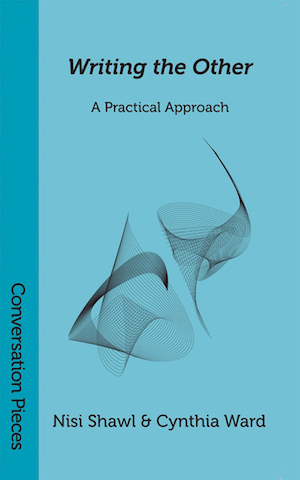
Like several of the other books on this list, Writing the Other grew out of a Clarion Workshop. In 1992, student in Nisi Shawl’s class debated whether it was ever OK for a writer to create characters with different backgrounds from their own. The consensus seemed to be that it wan’t a good idea, as the results can be hurtful and offensive—but Shawl saw potential in confronting the question more directly. With fellow Seattle sci-fi writer Cynthia Ward, Shawl created a workshop to deal with precisely these issues, and that eventually gave birth to this manual, that walks writers through exercises and writing prompts to help them write across difference without creating caricatures or stereotypes. You can read an excerpt here!
I Should Be Writing: A Writer’s Workshop by Mur Lafferty
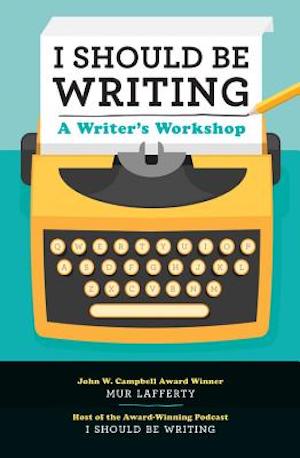
Campbell Award-winner Mur Lafferty’s craft book began life as a podcast, also titled I Should be Writing. The podcast served both to help her talk through her own fears of writing failure, encourage others, and create a community of people who wanted to write, but often felt that becoming a writer was an impossible goal. As she says in her book’s introduction:
I began recording my hopes, my fears, my dreams, and my setbacks, giving people an honest view of a beginning writer’s life—someone who could be easily discouraged but wasn’t going to give up. I focused not so much on the craft, because I was a newbie there. But I did know the brain weasels (or the bullies, which we will talk about later in this book) that will eat away at a writer, and how those weasels lie.
A few years later she started a follow-up podcast called Ditch Diggers, an honest look at the process of becoming a working, published writer, and some of the material from the podcast is also touched on in ISBW. In addition to advice on defeating the bullies, or at least coping with them, Lafferty’s book features a section of resources and a section on exercises and prompts, and an update to Ray Bradbury’s essay called “Care and Feeding of Your Author”, which tackles the pervasive myth that authors produce their best work through a haze of broken relationships and liquor-induced depression.
Steering the Craft AND The Language of the Night AND Conversations on Writing by Ursula K Le Guin
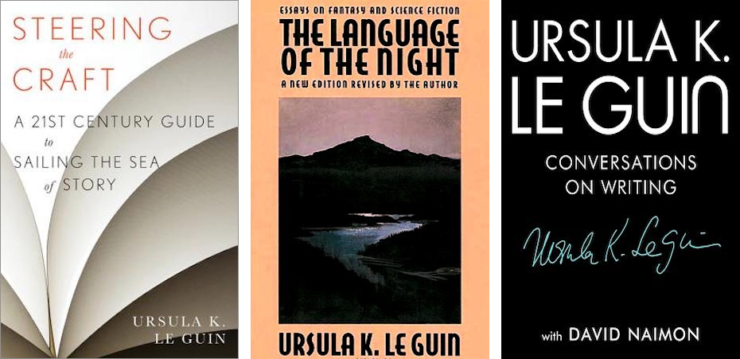
You’re damn right Ursula gets three books. Steering the Craft is the more “crafty” of the two, a clear, beautifully written guide that attempts to teach writers how to get comfortable enough with the tools of English to be able to play with them. Over ten chapters, Le Guin uses examples from classic literature to break down forms and techniques of writing, emphasizing that the purpose of language is to tell the story (not to show off), and using exercises to help writers experiment with words. The Language of the Night, on the other hand, is an assortment of essays, some on the state of SFF and some on craft. It was first published in 1979, and then updated in 1992, so obviously some of the opinions are a bit outdated!
If you deny any affinity with another person or kind of person, if you declare it to be wholly different from yourself—as men have done to women, and class has done to class, and nation has done to nation—you may hate it, or deify it; but in either case you have denied its spiritual equality, and its human reality. You have made it into a thing, to which the only possible relationship is a power relationship. And thus you have fatally impoverished your own reality.
You have, in fact, alienated yourself.
Shit. That’s from “American SF and the Other”, first published in 1975—maybe not as outdated as I’d hoped. Other essays in the book map the commodification of fantasy as a genre (“From Elfland to Poughkeepsie”), dig into Tolkien (“The Shadow and the Child”), and deconstruct her own ongoing relationship to gender in her work (“Is Gender Necessary?”) and they’re all useful for anyone who wants to write SFFH. Finally, Conversations on Writing is a book of wide-ranging talks with writer and podcaster David Naimon, in which Le Guin talks about her career, writing techniques, and, of course, her thoughts on the genre. The conversations were gathered into a book in 2018.
***
These are 18 of the best craft books I’ve read—I hope you find these books as helpful as I do!
Originally published May 2021.











Helpful post!
Also cf. works by William Zinsser, including On Writing Well, Writing to Learn, and Writing Places. Larry McMurtry’s non-fiction works contain some discussion of writing.
I really like Getting the Words Right by Theodore Cheney. It’s about editing and revising and has great examples, mostly at the sentence and paragraph level, of how revising and tightening can turn something fuzzy into something crisp, or something pedestrian into something that sings.
For a non genre but entertaining book on punctuation issues, try “Eats, Shoots and Leaves” by Lynne Truss
A tangentially related book that I really enjoyed is The Midnight Disease by Alice Flaherty. It’s about the nature of literary creativity and goes into the neurological aspects of language and related disorders while examining different authors and their work and process.
The lightbulb moment of my own craft process was Ben Bova’s THE CRAFT OF WRITING SCIENCE FICTION THAT SELLS where he shows how plot and character are the same thing. I always recommend it to any writer of popular fiction, science fiction or not.
As a writing teacher, I am not a fan of Stephen King’s ON WRITING because of his belief that his way is the only way, and, somehow, we all know instinctively about plot, etc. Spoiler Alert: Most of us don’t.
Great reading material, thanks! I have two more for the list: The joy of writing sex, by Elizabeth Benedict, and Haruki Murakami’s What I talk about when I talk about running.
I loved A Swim in a Pond in the Rain by George Saunders
A must read: Writing Down the Bones by Natalie Goldberg
@5 Count me as another fan of Bova’s book, a good guide that came into my life at just the right time.
Great post!
My favorite non-genre focused book on craft is Bird by Bird, by Ann Lamott. I laughed so hard and learned so much.
It’s lovely to see so much by LeGuin here. Either she or King must certainly be the most thoughtful heavily-published writers to write well about writing. But for the essentials of a writer’s craft, Nobody can compare to the much less famous Joseph Williams, as demonstrated by any of his several editions of the book most often titled something like “Style: Lessons in Clarity and Grace.”
As an lifelong voracious reader, and a mostly just random stuff for me writer, I want to say thank you for this list. And even though I only originally read it to see if my favorite book on writing was included, Mr.Stephen King’s most wonderful and thought provoking to me, I also discovered many new books to add to a never ending list of must reads.
This list of books are good for pantser writers, mostly because most of these books were written by pantser writers. I’m a plotter. I’ve looked through this list, and what I see are books I’ve wall-thumped because I wanted craft and technique, and that’s not their focus. YMMV. But I wouldn’t recommend any of these books to writers who outline before writing.
Strunk and White’s Elements of Writing should absolutely be on this list.
I enjoyed all of the above and agree Joseph Williams handle on crisp, style and clarity hit all the right buttons. I have to admit to being a bit of a scatterbrained, impulsive scribbler. I started writing when stranded in a big lonely house, alone after a bad car accident in Beltraneja Spain.
Six thick copybooks quickly filled up with characters that completely took over my vivid imagination, getting into all sorts of mischief & committing all sorts of atrocities. I’d no idea what so ever on how to write a book but had a lot of experience telling stories to my twelve younger siblings while growing up in Ireland. The writing of that book saved my sanity and possibly my life. Since then I’ve written 12 grammar books with Spanish translation and audios and three more novels for adults. I’m an avid reader of countless novels and love following and reading other writers stories.
I’d throw out King’s On Writing and replace it with Neil Gaiman’s The View From the Cheap Seats. King is a pretty hardcore prescriptivist when it comes to both language and storytelling, and his “my way is the only right way” attitude is a real turnoff. Gaiman’s book isn’t a book about writing, but it’s a book that teaches much more. There are insights into creativity and storytelling not to be missed.
But the book I recommend to all writers in every genre is Telling Lies for Fun and Profit, by Lawrence Block. I’ve read a lot of writing books over the years that told me how to write. Block was the first writer who convinced me that I could.
I’m not sure if David Lodge’s The Art of Fiction can help make one a better writer, but I think it made me a better reader. And it’s definitely a lot of fun.
The War of Art, by Steven Pressfield. It’s less about writing than fulfilling your creative dream whatever it us. But Pressfield is a novelist, and writing is his go to example. It’s also quite brilliant.
Excellent list. I would add Elmore Leonard’s “10 Rules of Writing”.
@18 “10 Rules recommendations of to Writing copy Elmore Leonard’s style” is fine if someone is a minimalist writer. I am not a minimalist writer, and I find nine out of the ten recommendations to be completely off base. So many of these lists are style guides, which is fine if that style is something that the writer prefers. But to cite them as more than that, I find irritating. Most of his advice, if you pay attention to the stories on the bookstore shelves, is ignored by a lot of published writers.
@2 Getting the Words Right is excellent. I’ve made a hobby of reading books about writing and storytelling theory, and of the few dozen I’ve read, it’s my favorite, and it is far and above the best I’ve read with a focus on the actual editing process.
I’d also include: Stein on Writing, Bird by Bird, and Self Editing for Fiction Writers
Yes! To the LeGuin and Morrison. LeGuin’s revision of Is Gender Necessary? Is a wonderful example of learning as you go and admitting error.
Also a big fan of Strunk and White.
My favorites are probably Writing Down the Bones and Bird by Bird, but I’m also a big fan of How Not to Write a Novel, by Howard Mittelmark and Sandra Newman. That’s another case of “I laughed so hard and learned so much.”
I was going to invoke Writing Down the Bones. Everybody beat me to it
Just back in print after a looong hiatus– Worlds of Wonder: On Writing Science Fiction & Fantasy by David Gerrold. Highly recommended, and not just for writing genre work.
Thank you very much for your recommendations! I would add “On Fairy-Stories” (1947) by J.R.R. Tolkien.
Francesca Lia Block’s THE THORN NECKLACE is excellent. A gift to writers from a beloved author who has published almost 30 books.
Philip Pullman’s DAEMON VOICES is transcendent. These are essays on storytelling, and they are mind-bending.
Lisa Cron’s WIRED FOR STORY is deep. It plunges the depths of how our brains are literally wired to receive and tell stories.